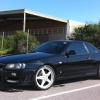Fuel Injectors! Which One For You?
Announcements
-
Similar Content
-
Latest Posts
-
I had absolutely no symptoms whatsoever that anything was wrong.... I'm very happy it was all spotto'd and re-bled and re-torqued and aligned though. Will be picking it up tomorrow and undoubtedly be like "Oh, that clunk is gone" "Oh, the car really wants to drive straight" "Oh, that pedal feels better" "Oh, it feels like I've gained 25hp" "Oh, the handbrake works now" It should have been a sign that the new Project Mu shoes had 3mm of pad depth on them out of the box, and the OEM ones from 25 years ago that we took out also had 3mm of pad depth, implying the issue was not, and never was the shoes, but we put that down to it not being adjusted correctly. It wasn't, but it wasn't even adjustable at all given one side was boned and the T Junction of the cables was on a 45 degree angle, the non-working side being the one on the massive angle. Obviously when I had adjusted it and reset it and re-tensioned it I had either got it stuck or something along those lines. Oh well. Live and learn and absolutely could have been catastrophically worse so I'm rationalizing it as a win, kinda. I also got the chance to measure the distance between rear rim and the suspension arm/shocks and found a 30mm rubber block only just doesn't fit there. Which is great to know before ordering wheels, when I assumed 30mm was easy. The man with the Porsche adapters has rims that use 23.9mm of that space, so it's safe to assume I have between 23.9 and 29.9mm of space there to play with on the inside. The wheels looked pretty stupidly pokey with the 20mm spacers on the rear, only for me to find that the studs come out another 12mm and the wheel doesn't actually sit flush with the hub because you're supposed to cut your original studs. The wheels do have cutouts that kinda accomodate it, but not fully. So my 20mm spacer was anywhere between 25mm and 35mm. ~25mm and send it will determine on where the wheels sit with the spacers on. When I put the pads in for the track day I will mess around with spacers (with wheels that do not clear studs properly when mounted to spacers) and do more math, for the last time, for the 7th time.
-
Lucky pick up Best to find these things before something horrible happened to the yoke flange thingies I would hate to think what would happen if it dropped the tailshaft Hopefully the holes are not flogged out in the yokes and it was just the bolts that got munted As for the hand brake.....ouch, look like the disc got rather hot, and I assume smokey, I recall when I had a front caliper seize on the Commodore, there was lots of smoke and the disc was glowing cherry red when I was able to eventually stop and have a look, and stopping a big heavy car, going down a big hill with some rather high RPM down shifts and some hand brake action is something that makes you think hard about life
-
One of the things that never seemed right was the handbrake. Put in some nice new Project Mu shoes. We figured the rears were out, so why not. We're right there. My handbrake never worked well anyway. Well, this is them, 15km later. 67fdcf94-9763-4522-97a4-8f04b2ad0826.mp4 Keen eyes would note the difference in this picture too: And this picture: Also, this was my Tailshaft bolts: 4ad3c7dd-51d0-4577-8e72-ba8bc82f6e87.mp4 It turns out my suspicions that one side of the handbrake cable was stretched all along were pretty accurate, as was my intuition that I didn't want to drop the tailshaft to swap them on jack stands and wasn't entirely sure about bolt torque. I have since bought the handbrake cables which have gone in. I'm very glad that I went to my mechanic friend who owns an alignment machine to get an alignment before the track day, because his eyes spotted these various levels of "WHAT THE f**k IS GOING ON HERE?". Turns out the alignment wasn't that bad, considering we changed the adjustable castor arms out for un-adjustable castor arms, and messed with the heights. Car drove pretty good with one side of the handbrake stuck on, unbleedable rear brakes, alignment screwy, and the tailshaft about to go flying and generally being a death trap waiting to happen! (I did have covid) (I maintain I adjusted the handbrake correctly, but movement caused shennanigans and/or I dislodged the spring on the problem side somewhat, or god knows what). G R E G G E D
-
Very interesting, im not sure how all those complications fit in to running a haltech instead of a stock ecu but I'm starting to think I'm a bit out of my league.
-
I just put 2 and 2 together. This is a Neo converted R32. The Neo ECU (in concert with the R34's AC controller) runs the AC quite differently to how the R32 ECU and AC controller do it. If you just drop it all in, it won't work. There is some tricky wiring required, including changing to the pressure switch that the Neo controllers want to see. I don't know what it is, because mine was done by a guru. It was a year or so after I did that transplant before he worked out what needed to be done.
-






Recommended Posts
Create an account or sign in to comment
You need to be a member in order to leave a comment
Create an account
Sign up for a new account in our community. It's easy!
Register a new accountSign in
Already have an account? Sign in here.
Sign In Now